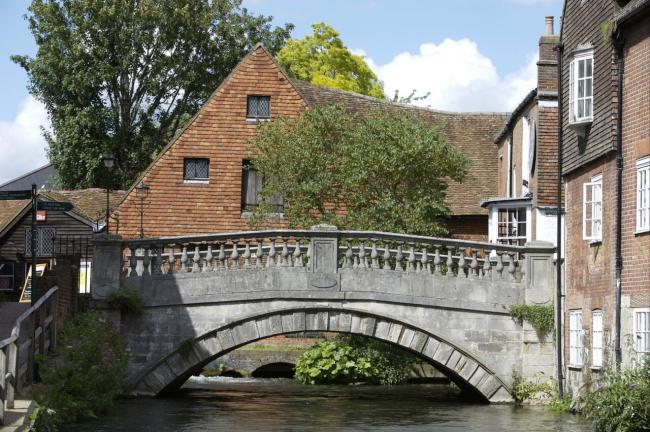A WINCHESTER landmark could be destroyed and a major bridge damaged if flood defence works are not carried out, a report has revealed.
Civic chiefs are growing concerned about the City Mill and City Bridge unless measures are taken soon.
They have rushed through a decision to approve an additional £500,000 spending.
The money, approved by Winchester City Council’s cabinet, will be spent on the second phase of the Durngate flood relief scheme, which aims to control the flow of water from the River Itchen.
The project, which includes installing new three sluice gates, had initially been estimated to cost £720,000. However, further investigative and technical work has meant significant changes to the design and brings the cost to £1.25million.
 Winchester City Mill
Winchester City Mill
It was agreed by councillors that the extra £500,000 would come from Community Infrastructure Levy (CIL) funding, money generated from a charge on new developments, with the remaining £30,000 left over from phase one.
According to a report to cabinet, the spending decision was treated as a matter of urgency due to fears of “existing external funding being withdrawn”.
“Given the importance of the scheme in reducing the threat of future flooding in the central area of Winchester, and the serious negative impact this would have on the city, it is recommended that the Council allocates a further sum of £500,000 of its CIL receipts to ensure the project is fully funded [and] can be implemented without undue delay.”
It added: “The National Trust has been repairing City Mill from the flood damage suffered in 2014, and have been carrying out modelling work on the stability of the structure. This has shown that the building is extremely vulnerable to damage from flooding, at water heights which are within the anticipated flood levels in the future according to the latest flood modelling.

“The analysis has shown that the damage would likely manifest as a total collapse of this Grade II* listed building, severely restricting river conveyance and immediately threatening the City Centre/Water Lane areas with substantial flooding; there is also a risk to the downstream City Bridge, a Grade I listed structure.
“Providing the second phase of the Durngate scheme would help protect the building and would thereby reduce the flood risk.”
Ric Weeks, Winchester City Mill’s Manager added: “We have been working in close partnership with Winchester City Council and the Environment Agency since the last major flood event in 2014, examining the risks and impact of flooding to the City Mill.
“As a result of this research and survey work, the National Trust carried out a major, publicly supported, structural restoration in 2018. A secondary phase of resilience works to mitigate the effects of flooding is underway now, and due to be completed this year.

“We are also working on a number of joint measures with the Environment Agency and the council to do everything we can to protect the Mill, the wider landscape and the community, in the event of future flooding.”
As previously reported, Winchester City Mill is the oldest working watermill in Britain and dates back more than a 1,000 years.
But during the winter of 2013/14, Hampshire suffered some of the heaviest rainfall in around 200 years, with areas of Winchester underwater, and the City Mill being damaged.
While the second phase of the project is ongoing, external funding would be sought by the council to get some of the additional spending back.
According to the report, the scheme would have a 100-year lifespan and would “require very little maintenance”. However, it later goes on to say: “There will be some maintenance requirements depending on the nature of the proposed scheme, which has yet to be fully designed.”
It did acknowledge animals including otters, water voles, salmon and bats could be impacted, but said mitigation measures would be provided.
Full planning permission still needs to be sought by the council before it can carry out the works.











Comments: Our rules
We want our comments to be a lively and valuable part of our community - a place where readers can debate and engage with the most important local issues. The ability to comment on our stories is a privilege, not a right, however, and that privilege may be withdrawn if it is abused or misused.
Please report any comments that break our rules.
Read the rules here